|
|
 |
|
Calanoida ( Order ) |
|
|
|
Clausocalanoidea ( Superfamily ) |
|
|
|
Aetideidae ( Family ) |
|
|
|
Aetideopsis ( Genus ) |
|
|
| |
Aetideopsis multiserrata (Wolfenden, 1904) (F,M) | |
| | | | | | | Syn.: | Faroella multiserrata Wolfenden, 1904 (p.117, Descr.F, figs.F); Pearson, 1906 (p.13, Rem.); Farran, 1908 b (p.29, Rem.);
Chiridius nasutus With, 1915 (p.81, figs.F); Sewell, 1948, (p.384);
? Aetideopsis rostrata : A. Scott, 1909 (p.40);
Chiridius multiserratus : Farran, 1926 (p.248, Rem.);
Aetideopsis pacifica Esterly, 1911 (p.315, figs.F); Brodsky, 1950 (1967) (p.149, figs.F); in CalCOFI regional list (MDO, Nov. 2013; M. Ohman, pers. comm.);
no Aetideopsis multiserrata : Brodsky, 1950 (1967) (p.147, figs.F); Vidal, 12971; Markhaseva, 1984 (p.512) | | | | Ref.: | | | Sars, 1907 a (p.6); 1925 (p.43, figs.F); Rose, 1933 a (p.91, figs.F); Jespersen, 1934 (p.53); Lysholm & al., 1945 (p.11, Rem.); Sewell, 1948 (p.499, 545, 550); Davis, 1949 (p.25, Rem.F); Vervoort, 1951 (p.80, Rem.); 1952 a (n°42, p.3, figs.F); 1957 (p.53, Rem.); Tanaka, 1957 a (p.37, figs.F,M); Vervoort, 1963 b (p.123, Rem.); Owre & Foyo, 1967 (p.43, figs.F,M); Tanaka & Omori, 1970 (p.111); Vidal, 1971 a (p.16, 112, figs.F); Park, 1975 b (p.274, figs.F,M); 1978 (p.111, figs.F); Bradford & Jillett, 1980 (p.19); Markhaseva, 1996 (p.37, figs.F,M, Rem.); Chihara & Murano, 1997 (p.681, Pl.30,31: F,M); Vives & Shmeleva, 2007 (p.538, figs.F,M, Rem.) | 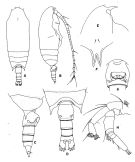 issued from : T. Park in Antarctic Res. Ser. Washington, 1978, 27. [p.112, Fig.6]. Female: A, habitus (dorsal view); B, idem (right lateral view); C, posterior part of prosome and urosome (right lateral view); D, idem (dorsal view); E, forehead (lateral view); F, rostrum (anterior); G, genital segment (ventral view); H, A2.
|
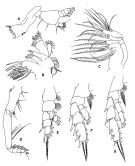 issued from : T. Park in Antarctic Res. Ser. Washington, 1978, 27. [p.113, Fig.7]. Female:A, Md; B, Mx1; C, Mx2; D, Mxp; E, P1 (anterior view); F, P2 (anterior); G, P4.
|
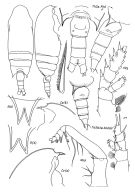 issued from : E.L. Markhaseva in Trudy Zool. Inst. RAN, St. Petersburg, 1996, 268. [p.38, Fig.22]. Female; From different specimens. R (a) and R (b): rostrum (anterior) (a) from 45°11'N, 152°28'E; (b): 48°33'N, 18°52'W; other figures: 43°52'N, 149°49'E.
|
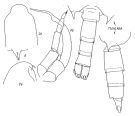 issued from : E.L. Markhaseva in Trudy Zool. Inst. RAN, St. Petersburg, 1996, 268. [p.39, Fig.23]. Male (from 43°52'N, 149°49'E). R: rostrum (anterior); Gn: genital segment. Male described here differs from Tanaka (1957) and Park (1975) in some details: structure of rostrum (lateral view), length of points of last thoracic segment and details of setation of oral parts.
|
 issued from : T. Park in Bull. Mar. Sci., 1975, 25 (2). [p.274, Fig.1] Female: a, forehead (lateral); b, rostrum (anterior); c, posterior part of metasome and urosome (dorsal); d, idem (left side).
|
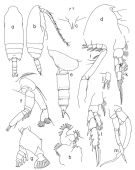 issued from : T. Park in Contr. Mar. Sci., 1976, 20. [p.275, Fig.2] Male: a, b, habitus (dorsal, lateral); c, rostrum (anterior); d, forehead (lateral); e, posterior part of metasome and urosome (right side); f, A2; g, mandibular palp; h, Mx1; i, Mxp; j, distal part of Mxp; k, P1; l, P2; m, fifth pair of legs (posterior). P1-P2: legs (anterior).
|
 issued from : O. Tanaka in Publ. Seto Mar. Biol. Lab., 1957, VI (1). [p.39, Fig.26]. Female: a, habitus (dorsal); b, forehead (lateral); c, last thoracic segment and genital segment (lateral left side); d, idem (dorsal); e, anal segment and furca (dorsal); f, rostrum; g, P1; h, P2. Nota: Rostrum highly chitinised and very prominent (the shape in lateral view differs somewhat from the figure given by Sars or A. Scott. Proportional lengths of urosomites and furca 35:24:17:10:14 = 100. A1 reaches back to distal margin of 2nd urosomal segment. mx1: outer lobe with 8 setae, exopod with 10 setae. Male: i, habitus (dorsal); j, forehead (lateral); k, rostrum; l, last thoracic segment (lateral); m, P5. Nota: Head and 1st thoracic segment fused, line of fusion between 4th and 5th thoracic segments scarcely visible in dorsal view. Rostrum: branches closely set together. Proportional lengths of urosomites and furca 16:34:23:16:1: 10 = 100. A1 extends to distal end of 2nd thoracic segment. Mx1: 1st outer lobe has 6 long and 3 short setae.
|
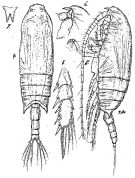 Issued from: G.O. Sars in Résult. Camp. Scient. Prince Albert I, 69, pls.1-127 (1924). [Pl.XIV, figs. 4-8]. Female: 4, habitus (dorsal); 5, idem (lateral left side); 6, forehead (lateral); 7, rostrum (frontal view); 8, exopodal segments of P3.
|
 issued from : C.O. Esterly in Univ. Calif. Publs Zool., 1911, 6 (14). [Pl.28, Figs. 24, 25, 30]. As Aetideopsis pacifica. Female (from San Diego Region): 24, habitus (lateral); 25, forehead (lateral); 30, rostrum. Nota: A1 23-segmented and do not extend back to the end of the cephalothorax. Urosome 4-segmented, 1st segment longer than any of the others, 2nd segment about as long as the 3rd and 4th together.
|
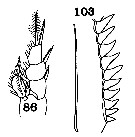 issued from : C.O. Esterly in Univ. Calif. Publs Zool., 1911, 6 (14). [Pl.31, Figs.86, 103]. As Aetideopsis pacifica. Female: 86, P1; 103, basal part of the serrate margin of the terminal bristle of exopodite segment of P4.
|
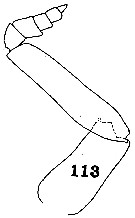 issued from : C.O. Esterly in Univ. Calif. Publs Zool., 1911, 6 (14). [Pl.32, Fig.113]. As Aetideopsis pacifica. Female: 113, Mxp (posterior).
|
 issued from : H.B. Owre & M. Foyo in Fauna Caribaea, 1967, 1, Crustacea, 1: Copepoda. Copepods of the Florida Current. [p.26, Figs.124, 125]. Female: 124, rostrum. Male: 125, rostrum.
|
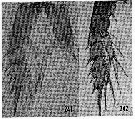 issued from : H.B. Owre & M. Foyo in Fauna Caribaea, 1967, 1, Crustacea, 1: Copepoda. [p.44, Figs.241-242]. Female (from Florida Current): 241, P2; 242, P3.
|
 Aerideopsis multiserrata Aerideopsis multiserrata female: 1 - Endopod of P1 with external lobe. 2 - Posterior corners of last thoracic segment not wing-like, not divergent (dorsal view). Genital segment (dorsal view) barrel-like without lateral swellings. 3 - Crest poorely developed, situated at the leel of A2. 1st and 2nd external spines of exopodal segments 1 and 2 of P1 reaching the base of next spine. 4 - Endopod of P2 2-segmented (though separation between segments may be incomplete). Points of last thoracic segment reaching or exceeding the midlength of genital segment. 5 - Anterior part of cephalon (lateral view) evidently prominent over rostrum (in front of it).
|
 Aerideopsis multiserrata Aerideopsis multiserrata male: 1 - Points of last thoracic segment reaching or exceeding posterior border of urosomal segment 1. 2 - Endopod of P1 with external lobe. 3 - Rostral rami spaced closely. 4 - Rostral rami not divergent.
| | | | | Compl. Ref.: | | | Grice, 1963 a (p.495); Grice & Hulsemann, 1965 (p.223, 231: Rem.); Harding, 1966 (p.17); Dunbar & Harding, 1968 (p.318); Vinogradov, 1968 (1970) (p.266); Soenen, 1969 (p.72); Roe, 1972 (p.277, tabl.1, tabl.2); Björnberg, 1973 (p.322, 389); Vives & al., 1975 (p.41, tab.II, III); 1972 a (p.333); Deevey & Brooks, 1977 (p.256, tab.2, Station "S"); Pipe & Coombs, 1980 (p.223, Table II, vertical occurrence); Buchanan & Sekerak, 1982 (p.41, vertical distribution); Vives, 1982 (p.290); Kovalev & Schmeleva, 1982 (p.83); Cummings, 1984 (p.163, Table 2); Lozano Soldevilla & al., 1988 (p.58 as Aetidiopsis); Kosobokova, 1989 (p.26); Hattori, 1991 (tab.1, Appendix); Richter, 1994 (tab.4.1a); Errhif & al., 1997 (p.422); Hanssen, 1997 (tab.3.1); Suarez-Morales & Gasca, 1998 a (p107); Razouls & al., 2000 (p.343, Appendix); Holmes, 2001 (p.45); Gaard & al., 2008 (p.59, Table 1, N Mid-Atlantic Ridge); Galbraith, 2009 (pers. comm.); Park & Ferrari, 2009 (p.143, Table 4, Appendix 1, biogeography); Matsuno & al., 2012 (Table 2); El Arraj & al., 2017 (p.272, table 2); Belmonte, 2018 (p.273, Table I: Italian zones); Chaouadi & Hafferssas, 2018 (p.913, Table II: occurrence). | | | | NZ: | 15 + 1 doubtful | | |
|
Distribution map of Aetideopsis multiserrata by geographical zones
|
| | | | | | | | | | Loc: | | | Antarct. (Indian, S & SE Pacif., Drake Passage), sub-Antarct. (SE Pacif.), Atlant. (tropical), Congo, G. of Guinea, Canary Is., Maroccan coast, off Madeira, Bay of Biscay, W Azores, G. of Mexico, off Bermuda: Station "S" (32°10'N, 64°30'W), Sargasso Sea, Davis Strait, Baffin Bay, Greenland Sea, Arct. (Fletcher's Ice Is.), Canadian abyssal plain, Iceland, Faroe Channel, Laptev Sea, off Ireland (S & W), Baie Ibéro-marocaine, Medit. (Alboran Sea, Habibas Is., Sidi Fredj coast, Balearic Sea, Marseille, SW Sardinia), Tyrrhenian Sea, ? Straits of Moluca, ? Halmahera Sea, Japan (Izu region, off Sanriku), Izu-Bonin Trench, Kuril-Kamtchatka, E Beaufort Sea, Wyville Thomson Ridge, Arct., Vancouver Is., NE Pacif. (off Cape Flattery), S Pacif, Chile, California, G. of California in Suarez-Morales & Gasca, 1998 a).
Type locality: North Atlantic | | | | N: | 57 | | | | Lg.: | | | (1) F: 2,8; (7) F: 2,88; (14) F: 2,8; (20) F: 3,04; 3; (37) F: 3,54-2,52; M: 3,25-2,7; (38) F: 2,64; (39) F: 3,13; M: 3,04; (59) F: 3,2-2,8; (113) F: 3,4-2,75; (143) F: 3,18; (197) F: 2,92-2,52; M: 2,86-2,7; (199) F: 2,81-2,51; (866) F: 2,2-3,54; M: 3,04; {F: 2,20-3,54; M: 2,70-3,25} | | | | Rem.: | meso-bathypelagic.
Sampling depth (Antarct., sub-Antact.): 0-1000-3000 m. Sargasso Sea: 1000-1500 m. Sub-Arct.: 530-580 m (Pipe & Coombs, 1980 at 60°N, 07°W).
For Vervoort (1963 b, p.123) the records specimens of Davis (1949, p.25) from off Cape Flattery (eastern Pacific) differ in minor particulars from those recorded from Atlantic localities, and considers these Davis' records with some reserve. The specimens recorded by A. Scott (1909, p.40) as A. rostrata, generally identified with A. multiserrata, also differ from Atlantic specimens in certain details. Amongst A. Scott's specimens of A. rostrata from Siboga collection Vervoort found a single immature female of A. trichecus (see in Vervoort, 1949, p.9). He points out that he does not consider A. trichecus to be identical with A. rostrata as described by A. Scott (1909, p.40), this in contradiction to Tanaka's statement (1957, p.40); Vervoort considers A. trichecus to be more closely allied (if not identical with) A. divaricata Esterly (1911, p.316) than either A. multiserrata or A. rostrata.
After Markhaseva (1996, p.37) A. multiserrata was recorded in the Arctic Ocean (Brodsky, 1950; Minoda, 1967; Vidal, 1971; Markhaseva, 1984), but according to the figures (Brodsky, 1950; Vidal, 1971) and the examined original material from the Arctic Ocean, it is A. minor and not A. multiserrata; thus the previous recordings of A. multiserrata in the Arctic Ocean are doubtful. | | | Last update : 25/10/2022 | |
|
|
 Any use of this site for a publication will be mentioned with the following reference : Any use of this site for a publication will be mentioned with the following reference :
Razouls C., Desreumaux N., Kouwenberg J. and de Bovée F., 2005-2025. - Biodiversity of Marine Planktonic Copepods (morphology, geographical distribution and biological data). Sorbonne University, CNRS. Available at http://copepodes.obs-banyuls.fr/en [Accessed December 24, 2025] © copyright 2005-2025 Sorbonne University, CNRS
|
|
 |
 |













